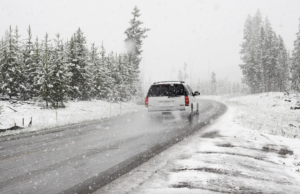With winter coming, safe driving a priority
Here in Iowa, we get a ridiculous amount of snow during the winter months. Many of us use cars to get to school and other locations, and, as we all know, snow isn’t kind on vehicles, so here’s how you can keep your transportation in reliable condition and ready to take on the ice.
First, check your antifreeze. Your antifreeze prevents overheating in your car engine, along with protecting if from corrosion and aids heat transfer. If you don’t have the right proportion, your car will overheat trying to warm itself up in the freezing temperatures and you’ll be stuck on the side of the road in the snow.
Before doing this, however, do it when your engine is cold. If you do it while it’s hot, the contents can and will spray out and burn you.
What you can do after checking your engines temperature is open your hood and look to see if the liquid in the radiator reaches the full line in the coolant reservoir. If it doesn’t, add a 50/50 mix of water and coolant until it does. However, some coolants will be premixed, so make sure to check the bottle. Afterward, close it up if you opened it and make sure you don’t have any leaks.
Next, if you can, shelter your car. Keeping it out of the snow will help keep it in top condition, but that’s not an option for everybody, so if you can’t than invest in a car cover for these upcoming winter months. Doing so will protect your vehicle from snow, ice, and salt used on the roads.
You should also check your heater system for your own sake. Make sure the core isn’t leaking, the blowers work and your window defroster is operating. You can’t drive if you can’t see. Along with this, it’s also a good idea to inspect your windshield wipers and make sure they aren’t worn or hardened. If they’re streaking (not wiping everything off, like rain) or making unusual noises, it may be time to replace them.
Another tip is to check your car’s electrical system, like your battery, less you be stuck on the road once again. Some signs you may need a new battery are a slow engine crank (if your car takes longer than usual to start up and throws a fit, be suspicious), an active check engine light, low battery fluid or a battery leak.
Next, and this is a constant tip to keep your car in good shape, is maintain fluids. Keep your gas tank up and don’t let your low gas light come on. It could mean future trouble since doing so wears on your engine.
This next step is another big important one and it involves your tires. When the cold temperatures come along, your tires pressure can change and may require a quick check up. All you have to do it check the tire pressure and put as much air in it as you need at a local gas station (if you don’t have equipment at home.) If you don’t know what the pressure needs to be, there are ways to check. In newer cars, the recommended tire pressure is commonly listed on a sticker in the drivers door. If it’s not, you can usually find it in the owner’s manual. However, if none of these options work for you, most passenger cars recommended 32 psi to 35 psi in the cold.
On the topic of tires, it’s always good to check your tire treads so you don’t go skidding off the road. To do so, use the Lincoln penny test. Insert a penny into your tire tread with the top of Lincoln’s head pointing inward toward the tire. If you can see all of Lincoln’s head, you need to replace it.
To finish up, always be prepared for a crash or getting stuck in the snow. Keep blankets in your car, a phone charger, a shovel if you can, water and a window scraper. You never know what you’ll need in a time of emergency. In the event that you do get stuck, always use your cellphone to call for help first.
Safe driving!







You must be logged in to post a comment Login